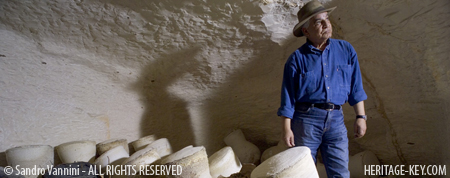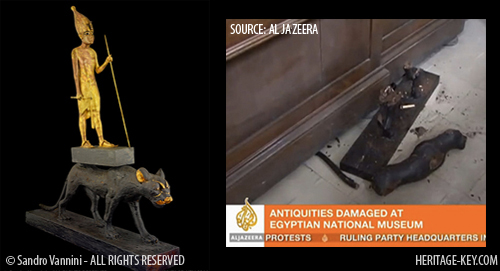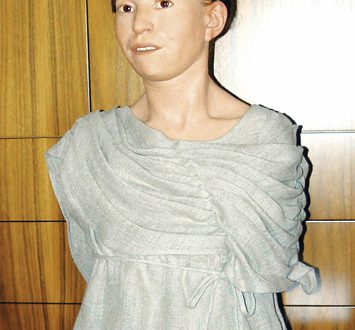 The Great Sphinx of Giza is one of the world’s largest and oldest monuments, and isn’t without its mystery. Theories fly around regularly about whether there are secret tunnels or hidden halls under the Sphinx, which Dr Zahi Hawass, currently starring in the ‘Chasing Mummies‘ series, insists is not the case in this Heritage Key video (Watch the Video). But my question is much more simple – Whatever happened to the nose of the Great Sphinx?
The Great Sphinx of Giza is one of the world’s largest and oldest monuments, and isn’t without its mystery. Theories fly around regularly about whether there are secret tunnels or hidden halls under the Sphinx, which Dr Zahi Hawass, currently starring in the ‘Chasing Mummies‘ series, insists is not the case in this Heritage Key video (Watch the Video). But my question is much more simple – Whatever happened to the nose of the Great Sphinx?
In a previous Heritage Key article, “Riddle of the Sphinx”, Robert Cook wrote about the legend that Napoleon’s troops used the Sphinx’s nose as target practice during the French invasion of Egypt in 1798. But did they really have such a disregard for thousands of years of history that they purposefully destroyed the nose of the Great Sphinx?
It’s a bit of a confusing mystery, mainly because of the poetic license employed by some of those who knew how to draw back in the 18th century. It wasn’t so much a case of there being a nose or not, but that the artists felt the Sphinx would be much more attractive and exotic to those viewing the works back in Europe if the monument didn’t have a ruined nose. After all, there’s not a demand for cats with missing noses in Battersea animal shelter.
In 1743, British traveller and writer Richard Pococke published an account of visiting the Great Sphinx of Giza, and his bookincluded a sketch of the monument with it appearing to show the nose intact. Pococke visited Egypt six years prior to publication, so his actual visit was in 1737. However, on a later visit in a book published in 1767, Pococke remarks that when “you arrive at the Sphinx [sic], whole enormous bulk attracts your admiration: but it is scarce possible to avoid feeling some indignation at those who have strangely disfigured its nose.”
An interesting statement from Richard Pococke, as it suggests that the lack of nose on the Sphinx may not actually have been as a result of thousands of years of erosion, but was ruined in a purposeful or accidental action. The previous sketch from 1737, assuming Pococke didn’t employ poetic license in the creation of it, would provide a date when the nose was still intact. Indeed, a prior sketch from Cornelis de Brujin in 1698 (Reizen van Cornelis de Bruyn door de vermaardste Deelen van Klein Asia, 1698) also showed the Great Sphinx of Egypt complete with a slightly odd looking nose. Perhaps if the original nose actually looked like the sketch by Cornelis de Brujin, that was reason enough to blast it off? Or maybe the sketch is just a dodgy scan..
Regardless, sketches drawn in 1755 by Frederic Louis Norden in‘Voyage d’gypte et de Nubie” (1755)of the Great Sphinx quite clearly show the nose is not there. It seems pretty unlikely to me that Norden would use poetic license to remove the nose from his sketches (unless he was into that sort of thing) so it’s reasonable to conclude that by this time, the nose was already missing for whatever reason. What it does prove is that Napoleon and his troops didn’t shoot off the nose of the Great Sphinx, as they didn’t launch an invasion of Egypt for another 40 years.
So that leaves a period of some 18 years (again assuming that everybody was sketching it accurately) when the nose was removed, and if you want to believe in Pococke’s account, destroyed by man. During the first half of the 18th Century, Egypt was in the midst of a power struggle between the Ottomans and the Mamluks, so perhaps this could be related to the missing nose of the Great Sphinx?Or maybe you have a better explanation?Feel free to leave a comment below!
HD Video: Drilling under the Sphinx (Featuring Dr Zahi Hawass and Dr Mark Lehner)
(Read the transcript of this video)
You can check out more fascinating videos from Heritage Key from Dr Zahi Hawass including his hunt to find KV64 in the Valley of the Kings (Watch the Video), and about discoveries being made in the River Nile(Watch the Video). You can also visit the Valley of the Kings online through Heritage Key Virtual – simply register for a free account, download our viewer and log on to discover the Wonders of the Ancient World online.




